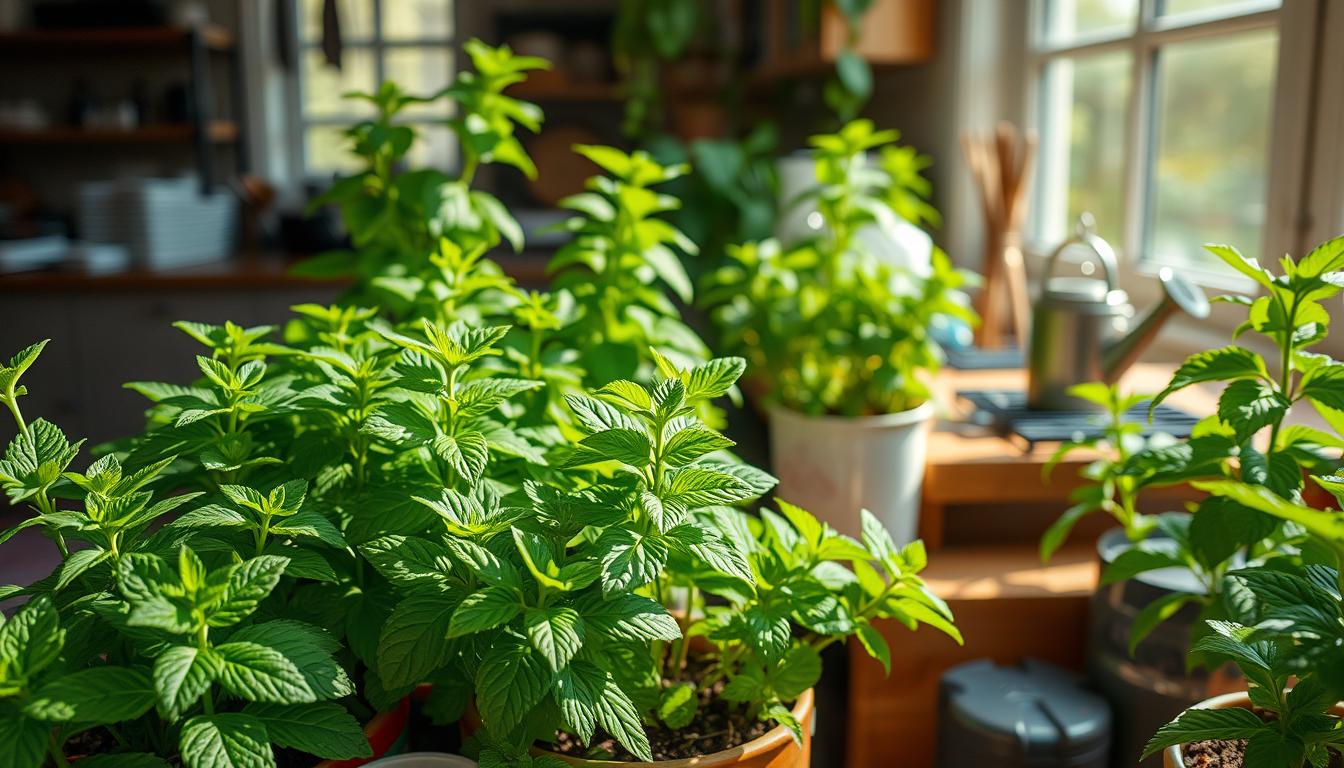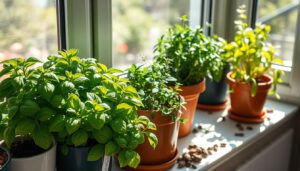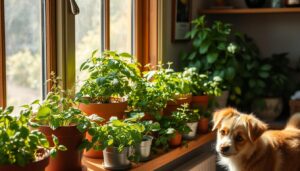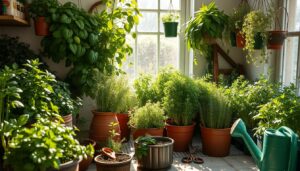Did you know mint is easy to grow indoors? A single plant can give you up to 10 times more leaves than you’ll use. This herb adds a fresh taste to your dishes and keeps pests away. It’s perfect for any indoor garden, whether you’re new to gardening or have years of experience.
Key Takeaways
- Mint is a hardy, fast-growing herb that can thrive indoors with the right care.
- Growing mint indoors provides a steady supply of fresh leaves for cooking, beverages, and more.
- Mint plants require specific lighting, temperature, and watering conditions to flourish indoors.
- Proper pruning and harvesting techniques are crucial for maintaining a healthy, productive mint plant.
- Mint can be propagated from seeds, cuttings, or transplants, making it an easy and affordable choice for indoor gardening.
Introduction to Growing Mint Indoors
Growing mint indoors brings many benefits to your home garden. You can have fresh, aromatic herbs all year. These herbs add unique flavors to many dishes. Mint is known for its health benefits, like helping with digestion and reducing inflammation.
Benefits of Growing Mint Indoors
With indoor mint, you can control the growing conditions for a great harvest any time of the year. This herb does well in many environments, making it perfect for indoor gardening. You can enjoy the fresh scent and taste of mint all year, adding freshness to your cooking.
Popular Indoor Mint Varieties
- Peppermint: Known for its bold, minty taste, peppermint is a popular choice for indoor growing, offering a refreshing addition to teas, cocktails, and desserts.
- Spearmint: This variety boasts a slightly milder, sweet flavor, making it a versatile option for both savory and sweet dishes.
- Apple Mint: With its delicate, fruity aroma, apple mint adds a unique twist to a variety of recipes, from salads to sauces.
- Chocolate Mint: Indulge in the rich, chocolatey notes of this specialty mint, perfect for infusing into hot beverages or incorporating into decadent desserts.
These are just a few of the many mint types you can grow indoors. Each has its own flavor and uses in the kitchen. Whether you’re an experienced cook or new to gardening, adding these herbs can make your meals more exciting and healthy.
Grow Mint Indoors Tips
Growing mint indoors is rewarding, giving you fresh leaves for cooking and herbal teas. To keep your mint healthy, pick the right containers and soil. Let’s look at what you need for successful indoor mint growing.
Choosing the Right Containers
For containers for growing mint indoors, go for ceramic self-watering planters or pots at least 8 inches/1 gallon big. These self-watering planters for mint keep the soil moist, which is key for the plant. Don’t use shallow containers because mint spreads out and needs room for its roots.
Soil Requirements for Indoor Mint
The soil for indoor mint should drain well and be a good potting mix for mint. Choose a standard potting mix made for herbs or veggies. Add a balanced plant food with nitrogen, phosphorus, and potassium (NPK 10-10-10) when you first pot it. Later, switch to a nitrogen-rich herb blend (NPK 10-5-5) for feeding as it grows.
| Container Size | Recommended Soil Volume |
|---|---|
| 8 inches / 1 gallon | 1 gallon |
| 10 inches / 2 gallons | 2 gallons |
| 12 inches / 3 gallons | 3 gallons |
Good drainage for indoor mint is key to avoid root rot. Make sure your container has enough drainage holes for water to drain out.
“Proper container selection and soil preparation are the foundations for a thriving indoor mint plant. With the right setup, you can enjoy fresh, flavorful mint year-round!”
Lighting Needs for Indoor Mint Plants
To grow mint indoors, you need enough light for it to thrive. Mint loves the sun and needs 5+ hours of direct sunlight or a DLI (daily light integral) of 15+ mol/m²/day. It can also grow with some indirect sunlight. But, the best spot is a bright, south-facing window for the right amount of light.
If your home doesn’t get enough sunlight, a powerful grow light is a great choice. These lights copy sunlight and give mint the light it needs. Place the grow light 6 inches away from the plant’s top and turn it on for 10 hours a day to match mint’s preferred long days.
“Proper lighting is crucial for growing healthy, productive indoor mint plants. With the right amount of illumination, you can enjoy a bountiful harvest of this flavorful, versatile herb all year round.”
With the right optimal light exposure, your indoor mint will thrive. Enjoy the scent and taste of fresh mint at home with the correct lighting requirements and grow light setup.
Temperature and Humidity for Indoor Mint
For growing healthy, flavorful indoor mint plants, it’s key to keep the temperature and humidity right. Knowing what mint needs helps you create the best conditions. This way, you get a lot of mint to enjoy.
Ideal Temperature Range
Mint loves cool weather and does best in temperatures between 60°F and 70°F (15°C and 21°C). Keep your mint away from direct sunlight or hot windows to avoid it getting too hot. This keeps the plant healthy and the mint tasting sweet.
Humidity Levels for Mint
Humidity is also crucial for mint. It likes the air to be 40-60% humid. You can mist the plant, use a pebble tray, or put the pot on a humidifier to keep humidity right. This stops leaves from curling or changing color.
By controlling the temperature and humidity, you make the perfect space for your mint. With the right care, you’ll have fresh, tasty mint all year.
Watering and Fertilizing Indoor Mint
Keeping the right moisture and nutrients is key for indoor mint plants to grow well. By using the right watering methods and fertilizers, your mint can flourish indoors.
Watering Techniques
Mint likes consistent moisture but shouldn’t sit in water. Let the soil dry out a bit between waterings. This depends on the pot size and your environment.
Water your indoor mint every 2-3 days. Check the soil and make sure water can drain well.
Fertilizer Options
Start with a balanced fertilizer (10-10-10 NPK) for your mint. Then, switch to a nitrogen-rich herb blend (10-5-5 NPK) monthly during the growing season. This keeps your mint healthy and strong indoors.
Follow these watering and fertilizing tips to keep your indoor mint plants happy. Managing watering indoor mint and fertilizing indoor mint right is key. It ensures your plants get the moisture requirements for mint and nutrient needs for indoor mint.
Starting Mint Indoors from Seeds, Cuttings, or Plants
Growing fresh mint indoors offers several options. You can start from seeds, cuttings, or transplant established plants. Each method has its own benefits. Let’s look at these approaches for a thriving indoor mint garden.
Planting Mint Seeds Indoors
Starting mint from seeds is simple. Put 3 seeds per 8-inch or 1-gallon container into the soil. Keep the soil warm, between 68-80°F, for 10-15 days. This will help the seeds germinate.
Propagating Mint from Cuttings
To propagate mint from cuttings, take stem cuttings and root them in water. This method quickly gives you new mint plants. Once roots appear, move the cuttings to soil-filled containers to start mint indoors.
| Method | Advantages | Considerations |
|---|---|---|
| Seeds |
|
|
| Cuttings |
|
|
| Purchased Plants |
|
|
Choose your method wisely. Check any mint plants you buy for pests or diseases before transplanting mint seedlings. With the right method, you’ll enjoy fresh mint’s vibrant flavor and aroma indoors.
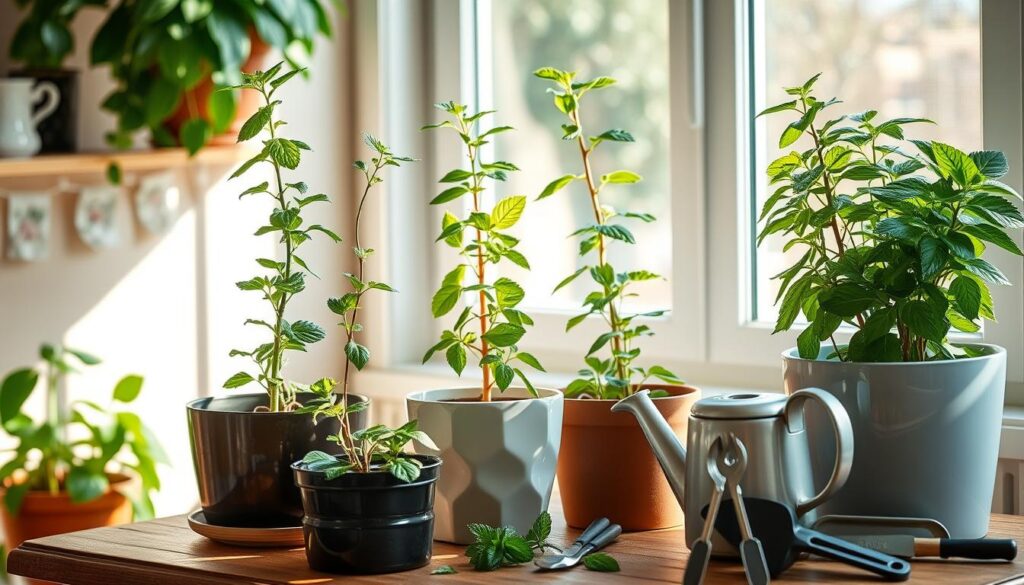
Pruning and Harvesting Indoor Mint
Keeping your indoor mint plants healthy and looking good takes some regular pruning. Start pruning when the plant has 3 sets of mature leaves. Pinch or cut off the top growth to make the plant branch out and fill in nicely.
Proper Pruning Techniques
Use clean, sharp shears or scissors when pruning your indoor mint. Don’t tear or rip the leaves, as it can hurt the plant. Cut off the top 1-2 inches of growth, leaving 2-3 sets of leaves on each stem. This keeps your mint compact and stops it from getting too long.
When and How to Harvest Mint
Start harvesting fresh mint indoors when your plant is well-established, with 3 or more sets of leaves. Harvest in the morning, before the heat of the day makes the oils fade. Just cut off the leaves you need, leaving 2-3 sets on each stem. This way, you’ll keep your mint plants healthy and have plenty of fresh mint for cooking.
“Regular pruning and harvesting are essential for keeping your indoor mint plants healthy, productive, and beautifully compact.”
Pest and Disease Control for Indoor Mint
Growing mint indoors can bring its own set of challenges. You might face pests and diseases that can harm your plants. It’s important to watch your plants closely and deal with problems fast to keep your mint garden healthy.
Aphids are a common pest for indoor mint. These tiny insects suck the sap, causing leaves to grow poorly and look misshapen. To fight them, check your plants often and add ladybugs or lacewings to your garden.
Spider mites also bother indoor mint, especially in dry, warm spots. They leave behind fine webs and dots on leaves. To get rid of them, make the air around your plants more humid and spray with neem oil.
Powdery mildew is another disease that can hit indoor mint, covering leaves in a white powder. To stop it, make sure air moves well and keep the area less moist. Using a baking soda solution can also help fight this disease.
Identifying and Controlling Mint Pests and Diseases
- Regularly check your indoor mint for pests like aphids, spider mites, or powdery mildew
- Add ladybugs or lacewings to your garden to control aphids
- Boost humidity and use neem oil for spider mites
- Improve air flow and treat powdery mildew with a baking soda solution
- Act fast to stop infestations or diseases from getting worse
By being alert and using natural pest control, you can beat common problems. This way, your indoor mint plants will stay healthy and flourish.
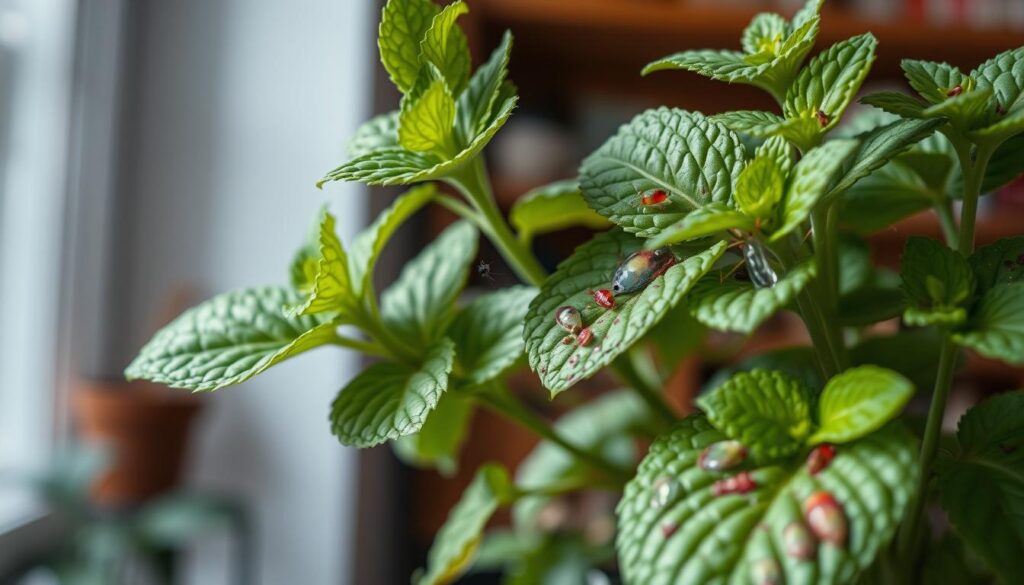
“The key to controlling pests and diseases on indoor mint is early detection and a proactive approach using natural, non-toxic solutions.”
Indoor Mint Companion Planting
Growing mint indoors can be a great idea. This herb is not only aromatic but also acts as a companion plant. It fits well in container gardens, keeping pests away and helping other plants grow better.
Some top plants that grow well with indoor mint are tomatoes, cabbage, and carrots. Mint’s strong scent keeps pests like aphids and spider mites away. Its growth also helps control weeds and keeps the soil moist for other plants.
When using mint as a companion plant, watch out for its fast growth. It can take over other plants quickly. Make sure to keep it in its own pot or area. This way, you get to enjoy mint’s benefits without it taking over your garden.
Trying out beneficial pairings for indoor mint can be exciting. By placing mint with the right plants, you create a balanced and healthy indoor garden. This approach makes the most of mint’s versatility.
“Mint can be a valuable addition to any indoor garden, not just for its culinary uses, but also for its ability to enhance the growth and health of other plants.”
Recipes and Uses for Fresh Indoor Mint
The leaves of your indoor mint can make many dishes better. They add flavor to drinks, savory meals, and desserts. This herb brings a burst of taste that will make your mouth water.
Refreshing Mint Drinks
Mint is great for making cool drinks. Add fresh mint to cocktails like mojitos and mint juleps for a fresh taste. You can also put mint in iced tea or lemonade for a refreshing drink.
Blend mint into smoothies or add it to icy watermelon for a refreshing treat. It’s perfect for hot days.
Savory Mint Dishes
Indoor mint is also good in savory dishes. Mix it into Greek yogurt for a cool side dish with grilled lamb or veggies. Add mint to salads with tomatoes, cucumbers, and feta for a taste of the Mediterranean.
Mint goes well with peas, new potatoes, and rich dishes like tagines and curries. It adds a fresh flavor to many meals.
Sweet Mint Desserts
Mint is perfect for desserts because it’s refreshing. Use it to make ice creams, puddings, and crème brûlée. It adds a fresh taste to these treats.
Add mint to fruit salads, compotes, and sorbets for a light, summery flavor. For a special treat, try mint-infused chocolate truffles or mint chocolate chip ice cream with your homegrown mint.
Fresh indoor mint can be used in many recipes, from drinks to desserts. Let your creativity flow and enjoy the many uses of this aromatic herb.
Conclusion
Growing mint indoors is a great way to have this fragrant herb all year. You just need the right steps for containers, soil, light, temperature, water, and cutting. This way, you’ll have fresh mint leaves for cooking, baking, and making cool drinks.
Mint is easy to care for and has many uses in the kitchen. This guide gives you all you need to start and keep a mint plant at home. It covers the summary of growing mint indoors, benefits of indoor mint cultivation, and tips for successful indoor mint growing.
Whether you want to improve your cooking, make refreshing drinks, or just enjoy the minty smell, growing mint indoors is fun and easy. It adds joy and flavor to your daily life.
FAQ
What are the benefits of growing mint indoors?
What are some popular indoor mint varieties?
What type of containers and soil are best for growing mint indoors?
How much light does an indoor mint plant need?
What temperature and humidity levels are ideal for indoor mint?
How often should I water and fertilize my indoor mint?
How can I start growing mint indoors?
How do I prune and harvest my indoor mint?
How can I prevent and treat pests and diseases on my indoor mint?
What are some good companion plants for indoor mint?
How can I use fresh indoor-grown mint in my cooking and drinks?
Source Links
- Your Guide to Growing Mint Indoors – https://www.tasteofhome.com/article/growing-mint-indoors/
- How to Grow Mint Indoors – https://www.geturbanleaf.com/blogs/herbs/growing-mint-indoors?srsltid=AfmBOoqzUYhtSIBQBXoNjyGZIK4QHZzJpwJBdU87GdP–6llVVvq2RcX
- The Best Way To Grow Mint Indoors For An Endless Supply Of Fresh Herbs – House Digest – https://www.housedigest.com/1633445/how-to-grow-mint-indoors/


